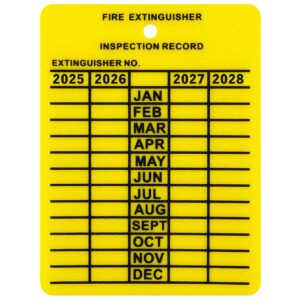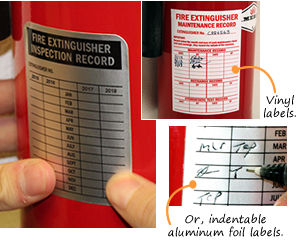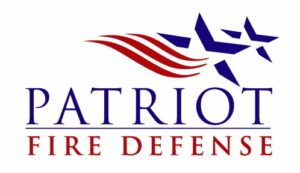Fire Extinguisher Inspection Tags: A Complete Brevard County, FL Guide
Do Fire Extinguishers Need Inspection Tags?
Yes – inspection tags are required by fire codes and standards. Every portable fire extinguisher in service must have a valid inspection tag indicating it has been serviced or inspected within the proper timeframe. Both NFPA standards and Florida laws mandate this. In fact, Florida’s fire code (based on NFPA 10) requires that annual inspections be performed by a licensed professional and that each extinguisher is tagged with an up-to-date inspection tag.
It is unlawful in Florida to place into service or inspect any fire extinguisher without attaching a completed tag that shows when the work was performed Simply put, if your fire extinguisher doesn’t have a current inspection tag, it’s not in compliance.
Why are these tags necessary? Inspection tags serve as proof of maintenance. Fire marshals, insurance inspectors, or safety officers can quickly glance at the tag to verify the extinguisher was checked recently and by whom. NFPA 10 (Standard for Portable Fire Extinguishers) and OSHA regulations require keeping records of inspections. For example, OSHA specifies that employers must record the annual maintenance date on a tag and retain this record for one year after the last entry. NFPA goes further by requiring all portable extinguisher inspections (monthly, annual, 6-year, and 12-year hydrostatic tests) to be recorded on a tag attached to the extinguisher. The bottom line is that inspection tags are absolutely necessary to meet the legal requirements and to ensure anyone can see the extinguisher is ready to go in an emergency.
Consequences of missing tags: An extinguisher without a current tag may be considered non-compliant during a fire inspection. Businesses in Brevard County could face fines or be required to immediately service and tag the units. More importantly, a missing or outdated tag means you can’t be sure the extinguisher will work when needed. For safety and liability reasons, always keep your extinguishers tagged and up to date.
How to Read a Fire Extinguisher Inspection Tag

Fire extinguisher tags contain key information about the extinguisher’s last inspection or service. Knowing how to read the tag will tell you if the unit is compliant and when the next service is due. Here are the typical elements you’ll find on an inspection tag and how to interpret them:
-
Service Date: Most tags show the date of the last professional inspection. Often, the month and year are hole-punched or marked to indicate when the last inspection took place.
-
For example, a punch through “Jul 2024” means the extinguisher was last serviced in July 2024. Generally, the extinguisher will be due for service one year from that date (so by end of July 2025 in this example), unless local authorities require a different interval. Always ensure the last inspection date is within the past 12 months.
-
Inspector’s Initials or Signature: The tag usually has initials or a signature from the technician who performed the inspection. This ties the service to an authorized person. In Florida, the name of the person or agency who performed the test is required to be recorded.
-
If you see initials, there is often a corresponding signature or full name on the back or a line that says “Inspected by: ____”. This tells you a certified technician checked the unit.
-
Company Name and License Number: A compliant tag will display the name of the fire protection company that performed the service (often printed on the tag). In Florida, companies servicing extinguishers must be licensed, and their company affiliation should be noted on the tag along with the inspector’s name.
-
This lets authorities and customers know which company to contact if there’s any issue. For example, a tag might read “ABC Fire Protection, License #123456, Phone 321-XXX-XXXX.”
-
Type of Service Performed: Many tags include boxes or sections to indicate what type of service was done. This can include annual inspection, maintenance/recharge, six-year maintenance, or 12-year hydrostatic test. For instance, a tag may have checkboxes for “Annual,” “6-Year,” or “Hydro.” If a technician conducted the six-year internal maintenance or a hydrostatic pressure test, it should be noted on the tag and often additionally on a separate metallic label on the extinguisher. When reading the tag, look for any special notations like “6-year” or a punched letter/number code indicating a more extensive service.
-
Expiration or Next Due Date: Some tags will explicitly list an expiration date or next due date for service. In many cases, this is simply one year from the last service. If the tag shows last serviced: 7/2024, then due: 7/2025 might be written. Not all tags state this outright, but the rule of thumb is annual service is due one year later. Always check if the tag is expired (over one year old) – if so, the extinguisher needs immediate professional attention.
-
Monthly Inspection Grid: Some inspection tags have a monthly inspection grid or table (often on the back of the tag or a dedicated area). This grid has 12 boxes or spaces for each month of the year. It’s used for recording monthly in-house inspections (more on that below). If present, you might see initials and dates in some of the month boxes, indicating that those monthly quick checks were done by staff. When reading the tag, if you see these markings, it shows the business has been performing its required monthly inspections. If the grid is blank or months are skipped, it could mean those monthly checks were not recorded – something an inspector might call out.
In summary, reading a fire extinguisher tag involves checking the last service date, verifying a technician/company signed off, and ensuring no required service is overdue. Every tag should state the date of the last inspection and the name or initials of who did it which gives you immediate insight into compliance. If you’re ever unsure, a fire protection professional (like an inspector from the fire department or a fire safety company) can help interpret the tag for you. But with the above points, you should be able to tell at a glance whether an extinguisher is up to date and who serviced it.
How to Fill Out a Fire Extinguisher Inspection Tag

Filling out a fire extinguisher inspection tag correctly is crucial for compliance. The process depends on the type of inspection (monthly quick-check vs. annual professional service). Here’s how to fill out or update the tag in common scenarios:
-
Monthly Inspections (User/Owner Performed): In Brevard County and everywhere in the U.S., monthly visual inspections of fire extinguishers can be done by a trained employee or responsible person (no special certification needed for this routine check)
-
After completing the visual inspection (ensuring the unit is in place, charged, and undamaged), you should record the inspection on the tag or log. If your extinguisher has a monthly inspection tag or grid, initial and date the tag for the month. For example, if you checked it on August 5, 2025, you might write initials “JD” and “8/5/25” in the August box or line. Some tags may only require initials with the understanding of the month/year. The key info to include is the month and year of the inspection and the inspector’s name or initials This simple notation meets NFPA’s requirement to record who performed the monthly check and when. If the tag does not have a dedicated space for monthly inspections, you can use a small adhesive label or a separate log sheet – but one way or another, document the monthly inspection.
-
Annual Inspection/Maintenance (Professional Performed): Annual servicing is performed by a licensed fire extinguisher technician, and they will attach a new tag or update an existing durable tag for that year. To fill out an annual service tag, the technician will typically punch out the month of service and write the year (or punch the year if the tag is pre-printed with ranges of years). They will then sign or initial the tag to certify the work. The tag should also list the company name and technician’s identifier if not pre-printed. According to guidelines, an annual fire extinguisher tag should include the inspection date and the inspector’s initials (or name) For example, after servicing, the tag might show “Serviced 09 – 2025” punched, with a signature or initials in the “by” field. If the technician replaced or recharged the extinguisher, they’ll note that as well (often by checking “recharged” on the tag). Only one tag is needed for the annual maintenance – NFPA 10 (2022) clarified that even though both an external inspection and maintenance are done during annual service, they should be recorded on a single annual tag
-
Six-Year Maintenance Tagging: Every 6 years, stored-pressure extinguishers require internal examination and maintenance (often called a six-year teardown). When this is done, the technician will fill out the regular annual tag for that year and additionally attach a secondary label (usually a small metallic or weather-proof sticker) to the extinguisher’s cylinder indicating the 6-year maintenance was performed To fill out the tag in this case, the process is similar to annual: punch/write the date and sign it. The separate 6-year label will have the month/year and technician’s identifier as well. The tag and the 6-year label should both be filled out with the inspection date, inspector’s name, and company This double-record ensures that anyone inspecting the extinguisher knows a six-year service was done (via the label) in addition to the annual tag.
-
Hydrostatic Test Tagging (5-Year/12-Year): Hydrostatic testing is the pressure test required every 12 years for most extinguishers (and every 5 years for some types like CO₂ or water extinguishers). After a hydro test, a new tag is typically attached because the extinguisher is disassembled and then recharged. To fill out a hydro test tag, the technician will record the date of the test, their name or signature, and the extinguisher’s serial number or ID on a special tag or label attached to the cylinder in Florida, as elsewhere, this information must be securely fixed to the extinguisher as evidence of the test. Essentially, the hydro test record might be a separate metal tag (sometimes stamped with the date) or a label, in addition to updating the normal hanging tag. If you are a technician, ensure the test date and your identification are clearly written; if you are an owner reading the tag, look for those details to confirm a hydro test was done.
Tips for filling out tags correctly: Always use a permanent marker or punch that won’t fade. Tags should be legible and durable (most official tags are card stock or plastic). Never fill out a tag for work you haven’t done – for instance, only licensed professionals should sign off on annual or six-year services. Florida regulations strictly prohibit anyone from tagging an extinguisher if it hasn’t met all the service standards When you do perform a check or service, fill out every required field on the tag: date, initials/name, and any other applicable information. If a tag is full or damaged, replace it with a new one and carry over the info (don’t remove old tags unless you replace them, as they are part of the record). Business owners should also maintain separate records of inspections whenever possible (NFPA advises keeping a log in addition to tags – but the tag is the first line of evidence.
By properly filling out inspection tags, you create a clear history for each extinguisher. This not only keeps you compliant but also gives peace of mind that each unit is being maintained regularly. If you’re ever unsure how to fill out a tag for your monthly checks, consult the extinguisher’s manual or ask your fire protection service provider for guidance.
Fire Extinguisher Monthly Inspection Tag Requirements

Regular monthly inspections are required for portable fire extinguishers in commercial and public buildings per NFPA 10 and Florida Fire Prevention Code. These are quick visual check-ups (not full services) that ensure the extinguisher is in good working order. Let’s break down what the monthly inspection involves and how to handle the tag requirements for these inspections:
-
Monthly Inspection Basics: NFPA 10 mandates that fire extinguishers **be inspected when first installed and at least once every month thereafter. In a monthly inspection, you or your staff should verify that:
-
The extinguisher is present in its designated location and mounted properly (not missing or removed).
-
It is visible and accessible – not blocked by storage, furniture, or other obstructions. There should be clear signage if needed to help find it.
-
The pressure gauge is in the green (for those with gauges), indicating it’s fully charged
-
The locking pin is intact and the tamper seal is unbroken
-
There are no visible damages: no dents, rust, or leaks on the cylinder; hose and nozzle are in good condition
-
The operating instructions on the nameplate are legible and facing outward.
-
The previous inspection tag is present and up to date (ensure the annual service tag hasn’t expired and past monthly initials are there, if applicable).
These steps can be done in a matter of minutes for each extinguisher. Many Brevard County businesses include this as part of their monthly safety checklist. It can be helpful to use a checklist or template (NFPA and OSHA provide guidance) to ensure you don’t miss any points. Monthly inspections do not require disassembling the extinguisher – they are purely visual/verbal checks (you can “heft” the extinguisher to feel if it’s full as an extra step.
-
-
Recording Monthly Inspections: After performing the check, you must record that it was done. NFPA 10 requires maintaining records of monthly inspections, either on a tag/label attached to the extinguisher or in an inspection login. At minimum, the record needs to show the month/year of the inspection and the person who did it Most businesses choose to initial and date the extinguisher’s tag for convenience. For example, if you have a tag with a grid on the back, you would initial the box for that month. If no tag space is available, you might stick a small monthly label on the extinguisher or keep a binder where you check off each unit. The NFPA allows either method as long as it’s accessible and kept for at least 12 months. In practice, keeping the record on the tag itself is easiest for inspectors to verify.
-
Monthly Tag Requirements: There isn’t a separate “monthly tag” that you buy for each month; rather, the requirement is that each monthly check is documented in some way. Many annual service tags accommodate monthly initials (e.g., with a calendar printed on the back). If your annual tag (from the fire service company) has a spot for monthly inspections, use it by writing your initials and the date each month. If not, you can attach a simple card or label. What’s important is that the record stays with the extinguisher for at least a year. NFPA 10 specifies keeping 12 months of inspection data either on the tag or in a file. That means an inspector in July 2025 will expect to see records going back to at least August 2024 for each extinguisher. Once you surpass a year, it’s okay to discard older records as new ones are added (though many companies keep them for longer).
-
Who Can Inspect Monthly: As noted, any competent person can perform the monthly inspections; you do not need a licensed contractor for this. In an office or store, this could be a safety officer, office manager, or owner. In a restaurant, it might be the manager on duty. Just ensure the person knows what to look for – a quick training or using an NFPA checklist can help. In Florida, it’s common for insurance or fire inspectors to ask who is handling monthly extinguisher checks, so assign this responsibility clearly in your team.
-
NFPA 10 (2022) Update – Emphasis on Monthly Inspections: A recent update to the NFPA 10 standard has put even more importance on monthly inspections. Because many owners were neglecting them, NFPA 10 (2022 edition) added a requirement that during the annual professional maintenance, the technician must verify all the items from the monthly check as well. In other words, the annual service now double-checks that nothing was missed during the year. However, this is not a substitute for doing your monthly checks – it’s a safety net. The intention is to catch any issues (like an obstructed extinguisher or a missing pin) that might have been overlooked, thereby reinforcing the need for those monthly walk-throughs. This update highlights that monthly inspections are considered critical to fire safety. It’s much better to find a problem in a monthly check and fix it immediately than to discover at the moment of a fire that the extinguisher isn’t usable.
-
Consistency and Reminders: For busy businesses in Brevard County, it’s easy to forget monthly inspections. Consider setting a recurring reminder (for example, on the first Monday of each month) to inspect all extinguishers. Keep spare tamper seals and pins on hand – if you find a broken seal during your check, you can replace it (after ensuring the extinguisher is still okay and not used). If you find any extinguisher damage or issues during a monthly inspection (e.g., low pressure, corrosion, or it’s been discharged), contact a professional service company immediately to service or replace it. Marking the monthly tag is important, but so is acting on any problems you notice.
In summary, monthly inspection tag requirements boil down to doing a thorough visual check every month and marking it on the tag or log with the date and your. This keeps you compliant with NFPA and Florida Fire Code, and more importantly, it ensures your extinguisher will be ready if ever needed. Remember, both NFPA and Florida state fire officials require an up-to-date tag showing at least the last inspection – so monthly initials plus the annual service punch together create a complete history of the extinguisher’s maintenance. By diligently performing and recording these inspections, Brevard County residents and business owners can maintain a safer environment and avoid violations.
Stay Safe and Compliant

Fire extinguisher inspection tags might seem like a small detail, but they play a huge role in fire safety compliance. They answer critical questions at a glance: Has this extinguisher been checked? When? By whom? By understanding the requirements for fire extinguisher inspection tags – from monthly check marks to annual service details – Brevard County business owners and residents can ensure they’re meeting both NFPA standards and Florida regulations. Always remember to keep tags updated and replace or service any extinguisher that isn’t in tip-top shape. The investment of time in regular inspections and record-keeping can truly pay off by preventing a small fire from turning into a disaster.
If you’re in Brevard County and find yourself searching for fire extinguisher inspection tags near me, look no further than your local fire protection professionals. Patriot Fire Defense is a Brevard-based fire safety company that can assist with all your extinguisher needs – from monthly guidance to annual inspections and tagging. We are familiar with Florida’s fire codes and the latest NFPA updates, ensuring your equipment stays compliant and ready. For expert help with fire extinguisher inspections, services, or to schedule a compliance check, contact Patriot Fire Defense. Our team is proud to help keep our Space Coast community safe through proper fire protection measures. Stay safe and proactive with your fire extinguisher maintenance – those little tags on your extinguishers are there to protect you, your property, and everyone around you.

